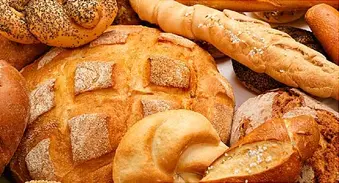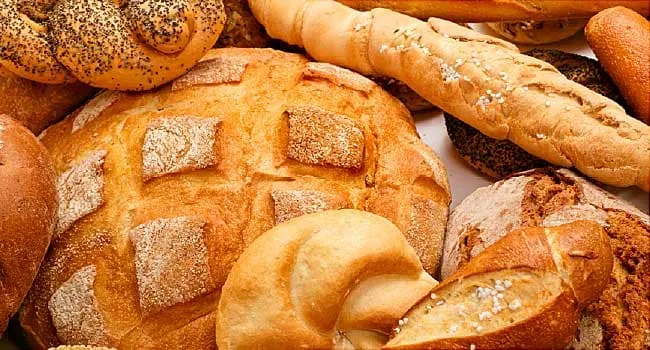Quiz: The Truth About Bread

Brown bread is always whole grain.
- True
- False
Molasses or other things can give bread a brown color. Read the ingredient list.The word "whole" should always appear before the name of the grain, such as whole wheat, whole oats, or whole rye. And it should be the first thing on the ingredient list.Don't be misled by labels that say "multi-grain," "stone-ground," "100% wheat," "cracked wheat," or "seven-grain." These usually aren't whole grain.
Which place is better to keep bread fresh for a few days?
- On the counter
- In the fridge
Putting bread in the fridge will actually make it go stale quicker.Bread from the grocery store will stay fresh for 2 to 4 days if you leave it on the counter. Bakery bread, which usually has fewer preservatives, will keep 1 to 3 days.If you want to store bread for a longer, put it in the freezer. It will stay fresh for 2 to 3 months.
Eating too much bread could raise your blood pressure.
- True
- False
If you eat toast in the morning, a sandwich at lunch, and a roll with dinner, you're not just loading up on carbohydrates. You're also eating a lot of salt. Most Americans get too much salt. When it comes to food sources, bread and rolls are the No. 1 source, beating out chips and other junk food.A single slice of bread isn't high in salt. A slice of wheat bread has about 137mg sodium. Eating bread several times a day adds up. Too much salt can raise blood pressure. It can put you at risk of heart attack or stroke.
"Enriched" bread is healthier than whole-grain bread.
- True
- False
The word "enriched' appears on white bread and other bread products made from refined grains. Refining helps make bread light and airy and gives it a longer shelf life.But it also strips away fiber, iron, and many B vitamins. "Enriched" just means that B vitamins and iron are added back after refining. But fiber may not be added back to "enriched" breads. Fiber is found in bread made with whole grains though, so that's your healthier choice.
Which is boiled before it's baked?
- Pita
- Croissant
- Bagel
That bagel that you like covered with cream cheese and a bit of lox is the only bread that's boiled before it's baked.Boiling gives traditional bagels their shiny, chewy crusts. Some companies steam their bagels instead of boiling them, however. How can you tell? Steamed bagels are puffier and softer.But you might want to be careful about how many you eat. Bagels can have a lot more calories than a slice of bread.
What's the best thing to do if you find mold on a slice of bread?
- Throw away the moldy slices
- Throw away the whole loaf
- Pick the mold off
Do you see green or black fuzzy spots on the piece of bread you're about to throw into the toaster? Toss out the whole loaf! Don't just throw away the pieces with the mold. That's because the mold may have spread to other parts of the loaf.There are a few different kinds of mold that pop up on bread. The blue-gray-green fuzzy mold is the same fungus that can produce penicillin.
Which is a health benefit of eating whole grains?
- Prevents migraines
- Cuts chance of heart disease
- Prevents acne
Fiber in whole grains may help reduce cholesterol and lower the risk of heart disease.Nutrients in whole grains help your body form red blood cells and keep your immune system healthy.
Which type of bread raises blood sugar the least?
- Whole-grain pumpernickel
- Whole wheat
- Sourdough
Your blood sugar levels go up after you eat foods that have carbohydrates. That includes bread. If you're worried about your blood sugar, whole-grain pumpernickel is your best bet. It keeps you full longer than other breads. And it causes the lowest and gentlest change in blood sugar. That's important for people with diabetes. In general, look for coarser, denser breads with a lot of grainy bits to avoid a spike in your blood sugar.
What's the difference between whole wheat and "white" whole wheat bread?
- The milling process
- The price
- The color of the wheat
"White" whole wheat bread -- which might sound odd -- is made with flour from white wheat, not the red wheat most bread is made from.The bran of white wheat is lighter and has a milder flavor, which might make this bread taste better to some people. Experts consider white wheat and red wheat to be the same nutritionally.
What are gluten-free breads made with?
- Potato flour
- Rice flour
- Both of the above
Gluten is a protein found in wheat, barley, and rye. People who cannot tolerate gluten should avoid breads and other foods made with those grains. Many gluten-free breads and mixes are made with white or brown rice flours and starches such as arrowroot, potato, and tapioca. Avoiding wheat can be hard. It's in most prepared foods and in some vitamins and lip balms.
Eating whole-grain bread can help you manage your weight.
- True
- False
The fiber in whole-grain breads can make you feel full longer and help you control your weight. But that doesn't mean you can have as much bread as you'd like. To lose weight, eat less, exercise more, and eat healthy foods. When picking bread, look for 16 grams of whole grains in a serving. If you are buying bakery bread that doesn't have a label, pick it up to see how heavy it is. Heavier breads are usually higher in whole grains.
How many grams of fiber should each slice have?
- At least 3
- At least 5
- At least 7
Choose whole-grain breads with at least 3 grams of fiber a slice. If you buy "double fiber" bread, you'll usually be getting 5 to 6 grams of fiber a slice. Just make sure that your double-fiber bread is whole grain and that it doesn't have artificial sweeteners in it.
